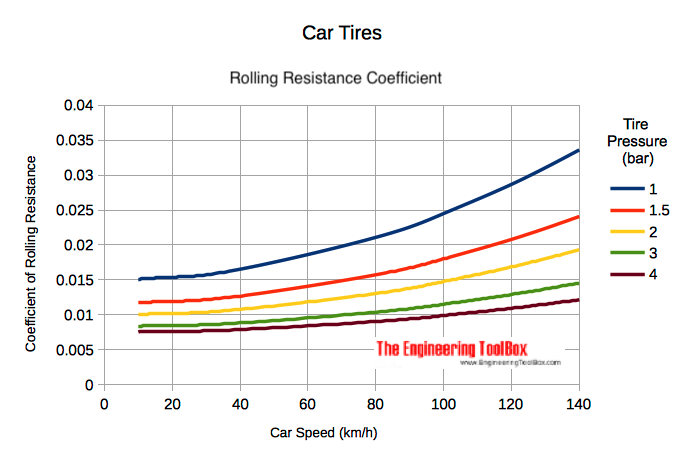Rolling Resistance (original) (raw)
The force that resists the motion of a body rolling on a surface is called the rolling resistance or the rolling friction.

The rolling resistance can be expressed by the generic equation
Fr = c W (1)
where
Fr = rolling resistance or rolling friction (N, lbf)
c = rolling resistance coefficient - dimensionless (coefficient of rolling friction - CRF)
W = m ag
= normal force - or weight - of the body (N, lbf)
m = mass of body (kg, lb)
ag = acceleration of gravity (9.81 m/s2, 32.174 ft/s2)
Note that the rolling resistance coefficient - c - is influenced by different variables like wheel design, rolling surface, wheel dimensions and more. Both rolling body and base are subject to deformations during rolling and large bodies rolls more easily than small bodies. Harder roller and base surfaces results in lower resistance coefficients. The rolling resistance coefficient for a car tire on asphalt is approximately 0.2 and the rolling resistance for a ball bearing is approximately 0.002.
The rolling resistance can alternatively be expressed as
Fr = cl W / r (2)
where
cl = rolling resistance coefficient - dimension length (coefficient of rolling friction) (mm, in)
r = radius of wheel (mm, in)
Rolling Friction Coefficients
Some typical rolling coefficients:
Rolling Friction Coefficients
| Rolling Resistance Coefficient | ||
|---|---|---|
| c | cl(mm) | |
| 0.001 - 0.002 | 0.5 | railroad steel wheels on steel rails, ball bearings |
| 0.001 | bicycle tire on wooden track | |
| 0.002 - 0.005 | low resistance tubeless tires | |
| 0.002 | bicycle tire on concrete | |
| 0.004 | bicycle tire on asphalt road | |
| 0.005 | dirty tram rails | |
| 0.006 - 0.01 | truck tire on asphalt | |
| 0.008 | bicycle tire on rough paved road | |
| 0.01 - 0.015 | ordinary car tires on concrete, new asphalt, cobbles small new | |
| 0.02 | car tires on tar or asphalt | |
| 0.02 | car tires on gravel - rolled new | |
| 0.03 | car tires on cobbles - large worn | |
| 0.04 - 0.08 | car tire on solid sand, gravel loose worn, soil medium hard | |
| 0.2 - 0.4 | car tire on loose sand |
Rolling Coefficients Cars
The rolling coefficients for air filled tires on dry roads can be estimated
c = 0.005 + (1 / p) (0.01 + 0.0095 (v / 100)2) (3)
where
c = rolling coefficient
p = tire pressure (bar)
v = velocity (km/h)
Example - Wheel Pressure & Rolling Resistance Coefficient
The standard wheel pressure in a Tesla Model 3 is 2.9 bar (42 psi). The rolling friction coefficient at 90 km/h (56 mph) can be calculated from (3) as
c = 0.005 + (1 / (2.9 bar)) (0.01 + 0.0095 ((90 km/h) / 100)2)
= 0.011
Increasing the pressure to 3.5 bar reduces the rolling resitance coefficient to
c = 0.005 + (1 / (3.5 bar)) (0.01 + 0.0095 ((90 km/h) / 100)2)
= 0.010
- or
((0.011 - 0.10) / 0.011) 100% = 9%
- 1 bar = 105 Pa = 14.5 psi
- 1 km/h = 0.6214 mph
Example - The Rolling Resistance of a Car on Asphalt
The rolling resistance for all four wheels in a car with total weight 1500 kg on asphalt with rolling friction coefficient 0.03 can be estimated with the generic equation 1 as
Fr = 0.03 (1500 kg) (9.81 m/s2)
= 441 N
= 0.44 kN
- compare car rolling resistance with car air resistance (drag)
The rolling resistance for one wheel can be calculated as
Fr = 0.03 (1500 kg / 4) (9.81 m/s2)
= 110 N
= 0.11 kN
Related Documents
Drag Coefficient
The drag coefficient quantifies the drag or resistance of an object in a fluid environment.
Fuel Consumption - mpg
Calculate fuel consumption in miles per gallon - mpg - calculator and consumption charts.
Impact Force
Impact forces acting on falling objects hitting the ground, cars crashing and similar cases.
Kinetic Energy
Energy possessed by an object's motion is kinetic energy.
New vs. Old Car Costs: A Comprehensive Cost Comparison
Compare the total cost of owning a new car versus an old car, including purchase price, maintenance, fuel efficiency, insurance, and depreciation. Use our detailed breakdown to make an informed financial decision before buying the next vehicle.



